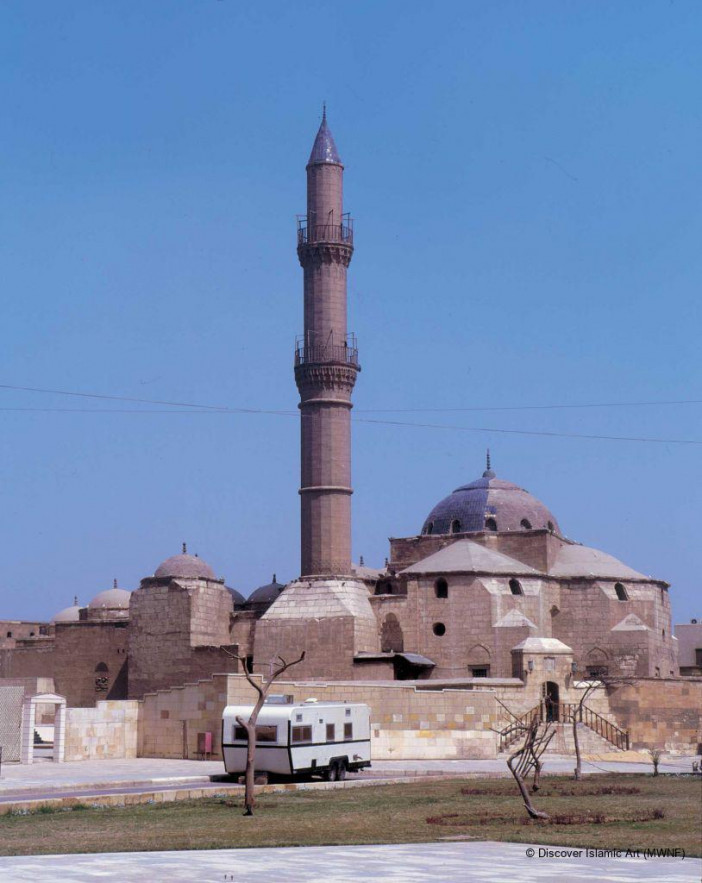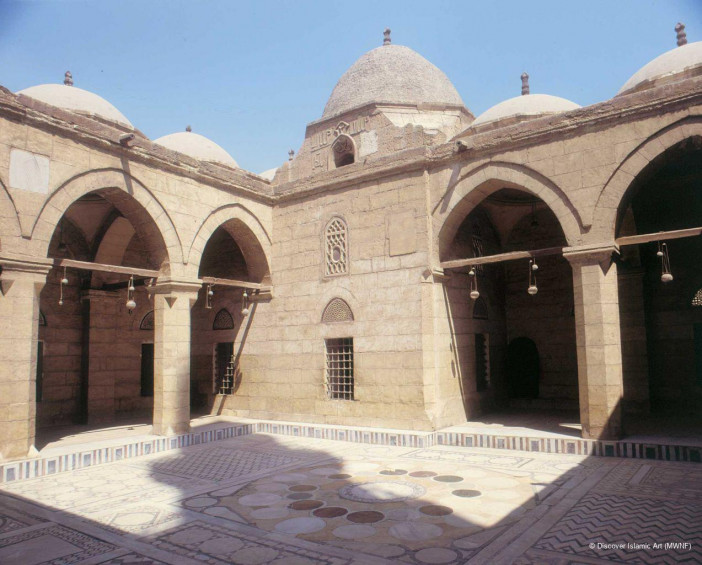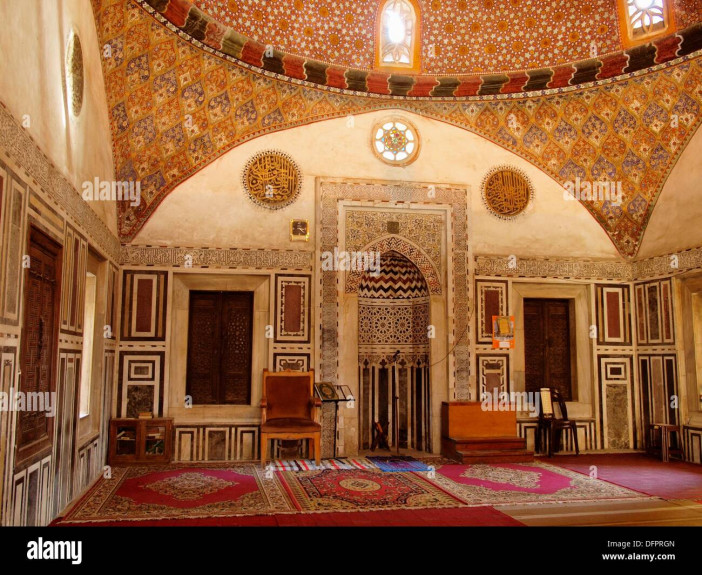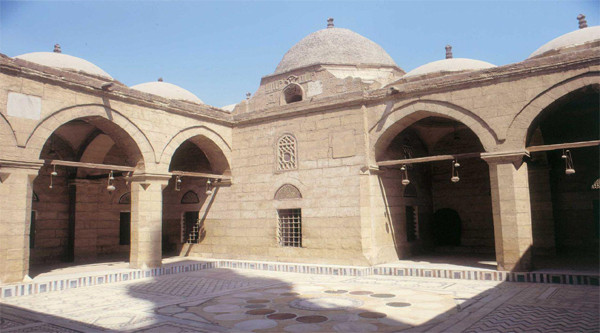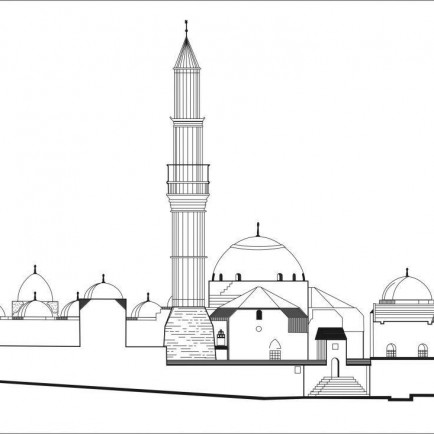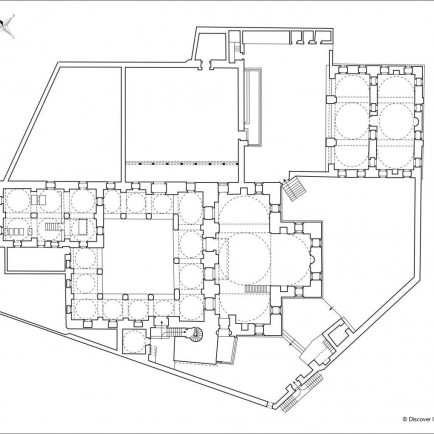Suleiman Pasha Mosque
History
This mosque is considered the first in the Ottoman style to be built in Egypt. It is in fact the result of the restoration and complete renovation of an earlier mosque built in AH 535 / AD 1140 by Abu Mansour Qastah Ghulam al-Muzaffar ibn Amir al-Jouyouch, governor of Alexandria under the Fatimids. The old one showed signs of dilapidation and was practically rebuilt in the Ottoman style, inspired by Istanbul models such as the Suleymaniye (AH 965 / AD 1558), then characterized by cupolas, half-cupolas, slender minarets and the ceramic tile covering of the interior walls.
Urban and Architectural
The ground plan consists of a prayer hall covered by the central cupola surrounded by half cupolas. It is preceded by a large open square courtyard bordered by four colonnades covered with small cupolas. The prayer hall has two iwans. The first, the iwan of the qibla wall (to the south-east), houses the mihrab marked by a pointed arch and polychrome marble decoration. The upper part of this wall has four circular cartouches containing inscriptions of extracts from the Koran, the name of the sponsor and that of Sultan Soliman al-Kanouni. note that the level of the marble floor of the second iwan (north-west) is lower than that of the qibla iwan. To the southeast is the marble minbar decorated with geometric patterns and gilt foliage. A door pierced in the northeast wall leads to the interior annexes, such as the ablutions room and the water reserve. The northwest wall, facing that of the qibla, has four arched niches, one of which houses a window and another a door that opens onto the courtyard. This precedes the prayer room to the west. In front of the northwest wall is a platform (dikkat al-mouballigh) supported by 10 wooden consoles and from which the daily prayers are recited before the faithful.
Description
References
https://books.openedition.org/ifpo/1665?lang=fr
Details
Location
2 Zoukak Saheb Al Magaes, Al Abageyah, El Khalifa, Cairo Governorate, Égypte
Worshippers
1250
Owners
Suleiman Pasha al-Khadim
Year of Build
1528
Area
2500
Drawings
Map
History
This mosque is considered the first in the Ottoman style to be built in Egypt. It is in fact the result of the restoration and complete renovation of an earlier mosque built in AH 535 / AD 1140 by Abu Mansour Qastah Ghulam al-Muzaffar ibn Amir al-Jouyouch, governor of Alexandria under the Fatimids. The old one showed signs of dilapidation and was practically rebuilt in the Ottoman style, inspired by Istanbul models such as the Suleymaniye (AH 965 / AD 1558), then characterized by cupolas, half-cupolas, slender minarets and the ceramic tile covering of the interior walls.
Urban and Architectural
The ground plan consists of a prayer hall covered by the central cupola surrounded by half cupolas. It is preceded by a large open square courtyard bordered by four colonnades covered with small cupolas. The prayer hall has two iwans. The first, the iwan of the qibla wall (to the south-east), houses the mihrab marked by a pointed arch and polychrome marble decoration. The upper part of this wall has four circular cartouches containing inscriptions of extracts from the Koran, the name of the sponsor and that of Sultan Soliman al-Kanouni. note that the level of the marble floor of the second iwan (north-west) is lower than that of the qibla iwan. To the southeast is the marble minbar decorated with geometric patterns and gilt foliage. A door pierced in the northeast wall leads to the interior annexes, such as the ablutions room and the water reserve. The northwest wall, facing that of the qibla, has four arched niches, one of which houses a window and another a door that opens onto the courtyard. This precedes the prayer room to the west. In front of the northwest wall is a platform (dikkat al-mouballigh) supported by 10 wooden consoles and from which the daily prayers are recited before the faithful.
Description


